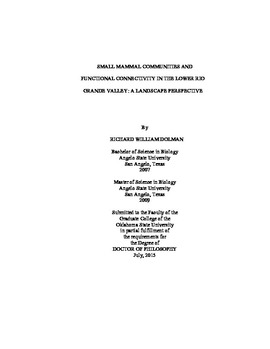| dc.contributor.advisor | Leslie, David M., Jr. | |
| dc.contributor.author | Dolman, Richard William | |
| dc.date.accessioned | 2016-09-29T18:39:51Z | |
| dc.date.available | 2016-09-29T18:39:51Z | |
| dc.date.issued | 2015-07 | |
| dc.identifier.uri | https://hdl.handle.net/11244/45251 | |
| dc.description.abstract | Habitat loss and fragmentation are major threats to global biodiversity, negatively affecting all major taxonomic groups. To mitigate these effects, the United States Fish and Wildlife Service manages three refuges in the Lower Rio Grande Valley (LRGV) of southern Texas with 1 goal of serving as a wildlife corridor connecting the Gulf coast with Falcon Reservoir. Since its creation in 1979, the LRGV National Wildlife Refuge (LRGVNWR) has grown to include 146 individual tracts, totaling about 44,500 ha primarily along the Rio Grande. The refuge offers the ability to conduct research in an increasingly common landscape pattern, a mosaic composed of native/restored habitat fragmented by agricultural and urbanized land use. | |
| dc.description.abstract | My study first examined how aspects of the habitat and landscape influenced small mammal diversity in LRGV refuge tracts. I live-trapped small mammals in 14 refuge tracts and calculated standard diversity indices from the resulting captures. Of 5,115 total captures, 49.7% were white-footed mice (Peromyscus leucopus) and hispid cotton rats (Sigmodon hispidus), representing 2 of 4 species statistically shown to prefer edge habitat. Although this demonstrated refuge lands were dominated by edge-adapted species, comparison to previous studies from within the refuge revealed a decrease in magnitude of their domination. Canonical redundancy analysis identified the amount of habitat available within 500 m of capture sites and average vegetation density within 150 m as important landscape features contributing to occurrence of small mammal species. These results demonstrated that the refuges in the LRGV are achieving their main goals to restore and maintain habitat. | |
| dc.description.abstract | Secondly, I examined effects of agricultural and urban fragmentation on genetic diversity and structure in populations of P. leucopus from 5 refuge tracts in the LRGV. Low nucleotide diversity combined with high haplotype diversity indicated a time of low effective population size of white-footed mice followed by recent population expansion. Localized population structuring suggested that P. leucopus was unable to effectively disperse through areas dominated by urbanization, while agricultural matrix offered no resistance. These results highlight the importance of preferentially acquiring and restoring land in areas dominated by an agricultural matrix to protect small mammal species from future urban encroachment. | |
| dc.format | application/pdf | |
| dc.language | en_US | |
| dc.rights | Copyright is held by the author who has granted the Oklahoma State University Library the non-exclusive right to share this material in its institutional repository. Contact Digital Library Services at lib-dls@okstate.edu or 405-744-9161 for the permission policy on the use, reproduction or distribution of this material. | |
| dc.title | Small mammal communities and functional connectivity in the Lower Rio Grande Valley: A landscape perspective | |
| dc.contributor.committeeMember | Van Den Bussche, Ronald A. | |
| dc.contributor.committeeMember | O'Connell, Timothy J. | |
| dc.contributor.committeeMember | Papes, Monica | |
| osu.filename | Dolman_okstate_0664D_14219.pdf | |
| osu.accesstype | Open Access | |
| dc.type.genre | Dissertation | |
| dc.type.material | Text | |
| thesis.degree.discipline | Natural Resource Ecology and Management | |
| thesis.degree.grantor | Oklahoma State University | |
